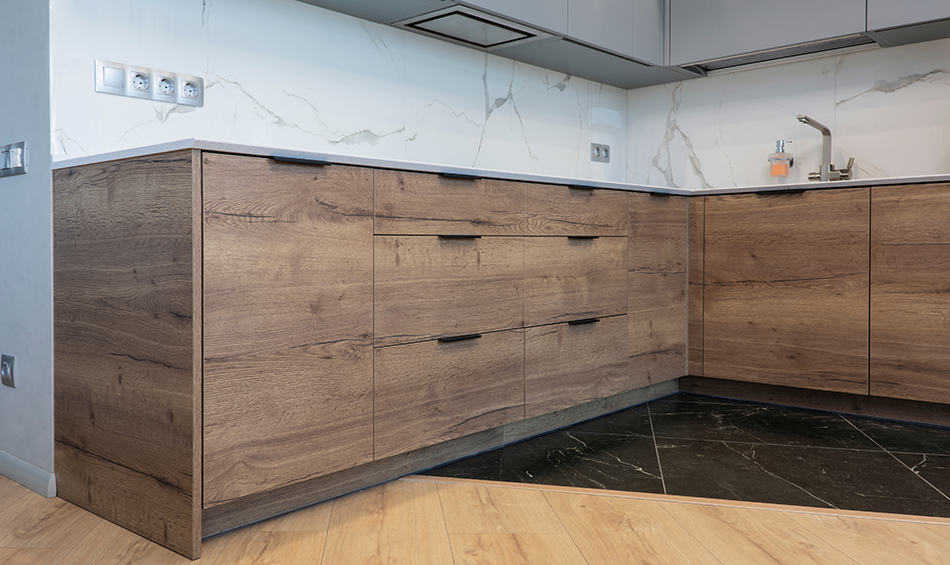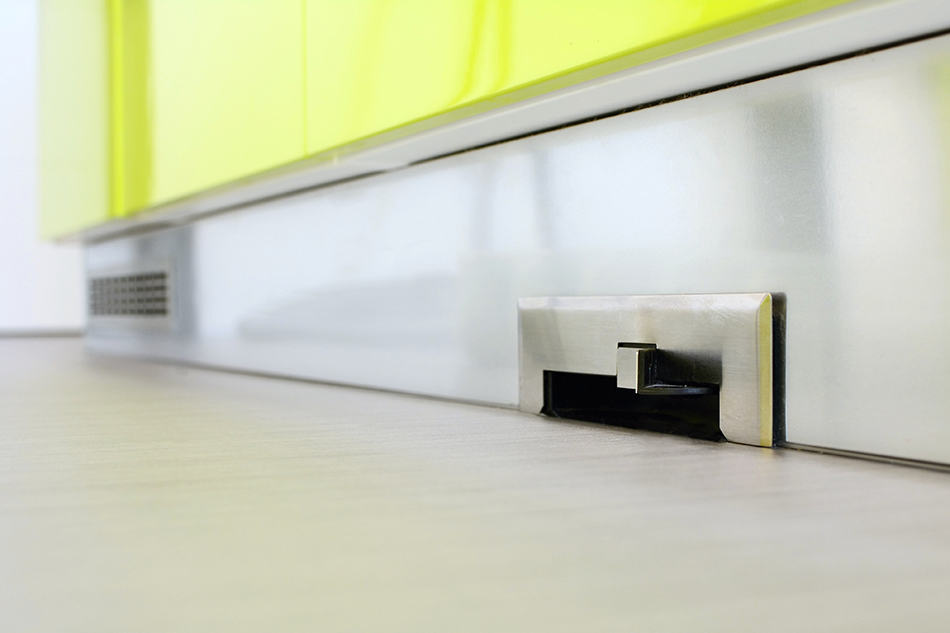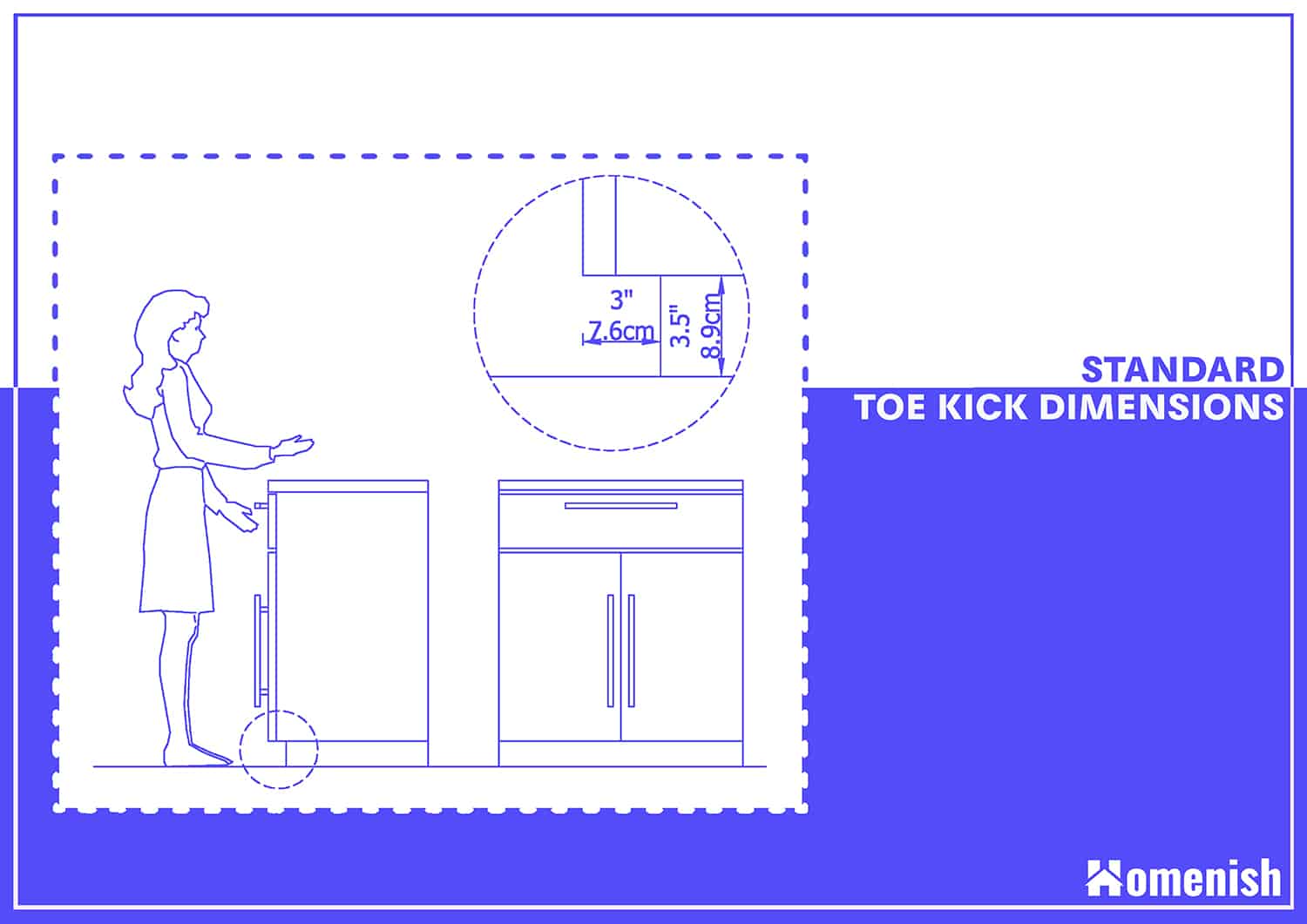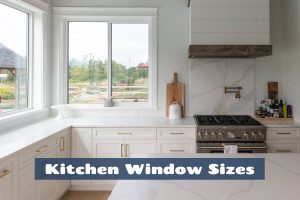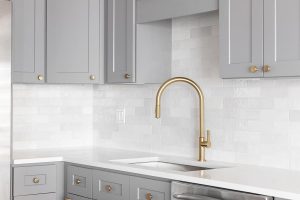Kitchen cabinet toe kick dimensions are one of the many measurements you’ll need to understand when designing a kitchen. The toe kick, also known as a kickboard, is a small detail, but it can affect the entire cabinet design and your comfort when standing at the kitchen counter.
Here we will explore exactly what a kitchen toe kick is and detail ADA toe kick dimensions, IKEA toe kick dimensions, as well as standard and non-standard toe kick dimensions.
What is a Toe Kick?
A toe kick is a name for the length of wood that is fixed in the space underneath a kitchen or bathroom cabinet. It goes directly from the floor to the bottom of the base cabinet itself and is usually adjoined to the legs of the cabinets to be held in place via brackets.
The brackets are typically ones that click into place, which means the toe kick can be removed fairly easily if you need to access underneath your base cabinets, for example, to clean it or reach nearby pipes.
The purpose of a toe kick is to allow you to stand at the kitchen counter in a comfortable position. The toe kickboard will be recessed slightly, allowing you to stand close to the base cabinet without hitting your toes.
Toe kicks also give kitchen base cabinets a more finished look and prevent people from being able to see underneath the cabinets. They create a custom feel so that the cabinets look like they were made for the space.
Standard Toe Kick Dimensions
A standard cabinet toe kick has a height of 3.5 inches up to a maximum of 4 inches. The standard depth (distance from the kitchen base cabinet to the toe kickboard) is 3 inches. Toe kickboards can be as long as 9 feet and will be cut down to size on-site to fit the kitchen cabinets.
Here are the specific dimensions illustrated by a drawing. Read all details in the below sections.
Height
The height of a standard toe kick is three and a half inches, with some standard toe kicks measuring a maximum of 4 inches. If you want your toe kick to be any taller than this, you will need a carpenter to make a custom toe kick. If you have bought standard-sized kitchen cabinets, then they will be compatible with standard-sized toe kicks.
Base cabinets stand on legs, which, if they are designed to be hidden behind toe kicks, will be made from plastic. These plastic legs will be a standard size, but some do have the ability to be twisted to extend the height or drop the height of the base cabinet.
If you have base cabinet legs that have an alterable size, then you’ll need to measure the gap between the floor and the base cabinet to ensure you choose the correct size of the kickboard, or you can adjust the legs so that their height matches the height of the cabinet toe kick.
Depth
The standard depth of toe kickboards is 3 inches. This is the measurement from the front of the kitchen base cabinet back to where the toe kickboard is installed. This means that when you are standing up against the cabinet, your feet have 3 inches of allowance where you can stand without accidentally stubbing your toes.
Cabinet toe kick depth isn’t just to keep your feet happy, but it actually allows you to stand in a natural posture while working at the kitchen countertops to avoid back pain. If your toe kickboards were flush with the base cabinets, you would have to stand further back from the cabinets when working at the counter, which would cause you to lean your upper body forward or hunch over your shoulders.
Length
Toe kickboards can come in lengths as long as 9 feet, and the board will be cut down to size on-site so that it fits perfectly underneath the base kitchen cabinets.
When assessing how much toe kickboard you need, you should measure the total length across the bottom of your base units and then add 10% to make allowances for cutting. If you have a straight run of base cabinets that are longer in total than 9 feet, then you can get custom toe kickboards made in longer lengths, or you can have two kickboards joined together.
Non-Standard Toe Kick Dimensions:
Height
In some instances, you might want custom toe kickboards made outside of the standard sizes. If you are tall, you may want to have a kitchen counter at a slightly greater height than is standard. This is because hunching over to prepare food at the kitchen counter can cause back pain or posture problems.
If you are a keen baker or someone who spends a lot of time working at the kitchen countertop, then a taller height of kitchen cabinet could be very beneficial. To achieve this, you could have base cabinets custom-made to be larger than standard, or you could buy a standard-sized kitchen cabinet but raise them up higher off the ground and hide the underneath space with a toe kickboard that is over the standard height of 4 inches.
Having a custom-made toe kickboard would be much more cost-effective than having all of your kitchen cabinets custom-made if the standard countertop height doesn’t work for you. Similarly, if you struggle to reach a standard kitchen countertop, you might want to lower the height of your base cabinets.
You can do this by having toe kickboards custom-made to a shorter height. You shouldn’t remove the toe kickboards altogether because if your floor isn’t perfectly even, then the cabinet doors may not open. Toe kicks also provide clearance for cabinet doors so that they aren’t opening against the floor.
Depth
The standard depth of toe kickboards is 3 inches, but this can be adjusted if you wish. If you have large feet which frustratingly keep banging up against the cabinet toe kickboard when you’re working in the kitchen, then you might be inclined to have new toe kickboards fitted further back than the standard 3 inches.
The only element which will need to be altered is where the legs are fitted on the base cabinets because these could get in the way of having the toe kick installed at a greater depth if they are close to the front of the cabinet.
You should avoid making the depth of the toe kick any smaller than 3 inches because this will negatively affect your posture at the countertop and could also prevent you from standing close enough to the cabinets to be able to reach up into the wall cabinets.
ADA Compliant Kick Board Dimensions
The ADA (Americans with Disabilities Act) requires that cabinet toe kicks are at least 9 inches in height and 9 inches in depth. This is to ensure that wheelchair users or anyone using other types of disability equipment can safely and comfortably access the kitchen.
